MITSUBISHI ECLIPSE 1993 User Guide
Manufacturer: MITSUBISHI, Model Year: 1993, Model line: ECLIPSE, Model: MITSUBISHI ECLIPSE 1993Pages: 57, PDF Size: 4.18 MB
Page 11 of 57
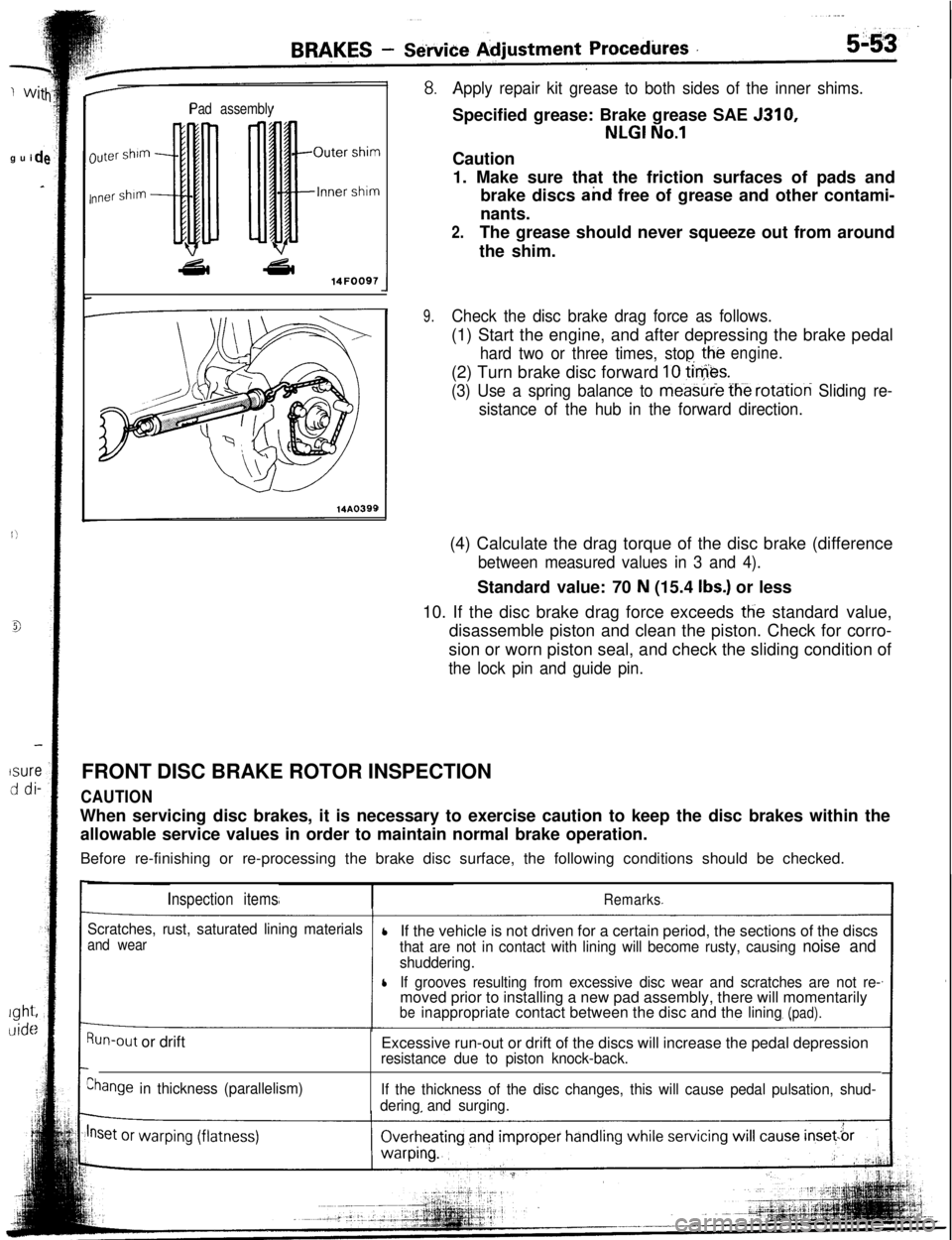
guiisur
dd
lght
clidc
Pad assembly
luter shim
nner shim
43l a14FOO97
14A0399
Apply repair kit grease to both sides of the inner shims.Specified grease: Brake grease SAE 5310,
NLGI No.1Caution
1. Make sure that the friction surfaces of pads and
brake discs and free of grease and other contami-
nants.
2.The grease should never squeeze out from around
the shim.
9.Check the disc brake drag force as follows.(1) Start the engine, and after depressing the brake pedal
hard two or three times, stop the(2) Turn brake disc forward
10 tie&.
engine.
(3) Use a spring balance to meastiie fh-e rotation Sliding re-
sistance of the hub in the forward direction.(4) Calculate the drag torque of the disc brake (difference
between measured values in 3 and 4).Standard value: 70
N (15.4 Ibs.) or less
10. If the disc brake drag force exceeds
tlie standard value,
disassemble piston and clean the piston. Check for corro-
sion or worn piston seal, and check the sliding condition of
the lock pin and guide pin.FRONT DISC BRAKE ROTOR INSPECTION
CAUTIONWhen servicing disc brakes, it is necessary to exercise caution to keep the disc brakes within the
allowable service values in order to maintain normal brake operation.
Before re-finishing or re-processing the brake disc surface, the following conditions should be checked.
Inspection itemsRemarks
Scratches, rust, saturated lining materials
and wearlIf the vehicle is not driven for a certain period, the sections of the discsthat are not in contact with lining will become rusty, causing noise and
shuddering.
lIf grooves resulting from excessive disc wear and scratches are not re-moved prior to installing a new pad assembly, there will momentarily
beinappropriatecontact between the disc and thelining(pad).
Run-out or drift
Ehange in thickness (parallelism)Excessive run-out or drift of the discs will increase the pedal depression
resistance due to piston knock-back.
If the thickness of the disc changes, this will cause pedal pulsation, shud-
deringand surging.
Page 12 of 57
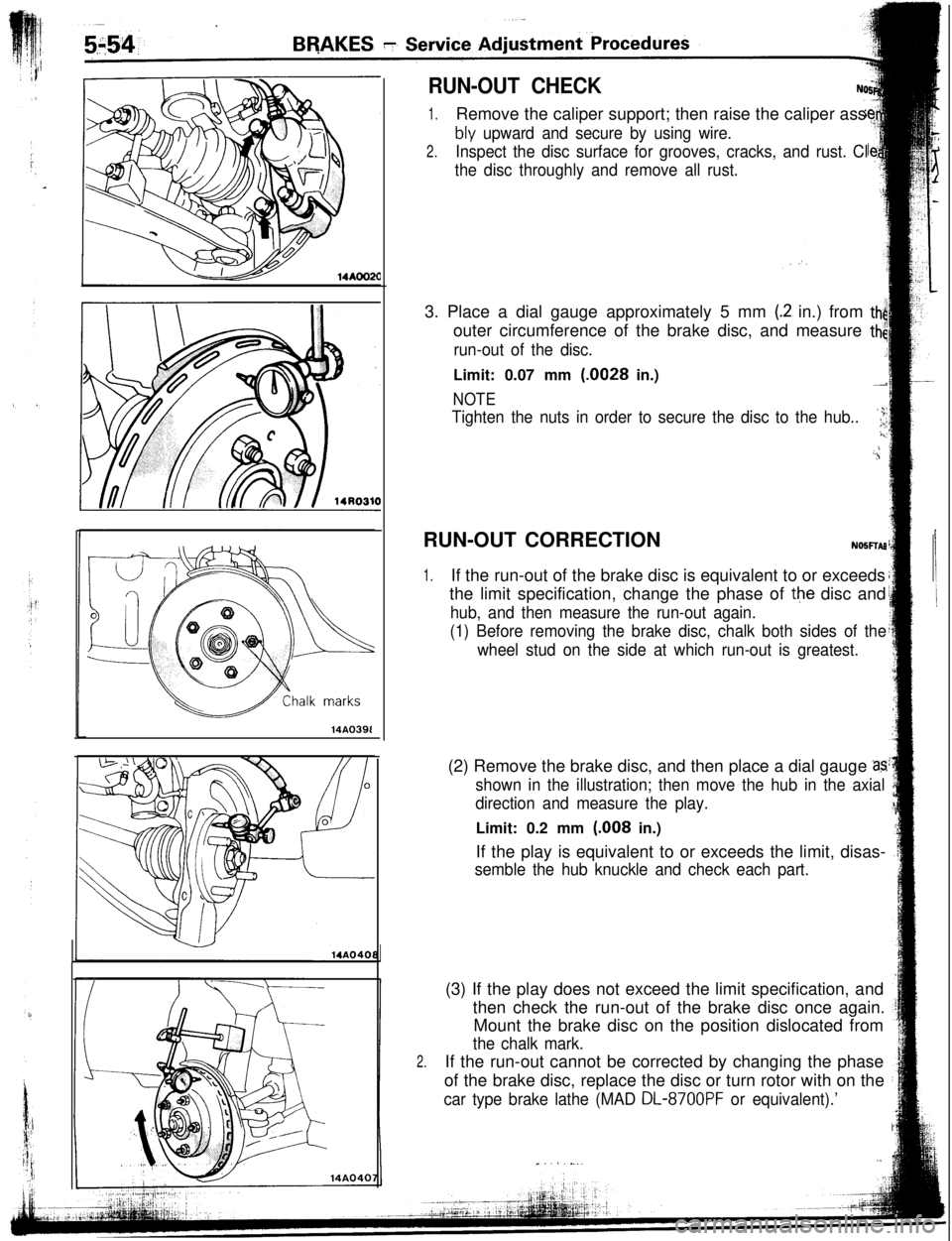
14A0391
RUN-OUT CHECK
1.Remove the caliper support; then raise the caliper ass
bly upward and secure by using wire.
2.Inspect the disc surface for grooves, cracks, and rust. Cl
the disc throughly and remove all rust.3. Place a dial gauge approximately 5 mm
(.2 in.) from thiouter circumference of the brake disc, and measure
tt$
run-out of the disc._iLimit: 0.07 mm
(.0028 in.)-2
NOTE
Tighten the nuts in order to secure the disc to the hub..‘l;i,!
..,;RUN-OUT CORRECTION
NOSFTAB
1.If the run-out of the brake disc is equivalent to or exceeds
the limit specification, change the phase of
the disc and
hub, and then measure the run-out again.
(1) Before removing the brake disc, chalk both sides of the
wheel stud on the side at which run-out is greatest.(2) Remove the brake disc, and then place a dial gauge
2s
shown in the illustration; then move the hub in the axial
direction and measure the play.Limit: 0.2 mm
(.008 in.)
If the play is equivalent to or exceeds the limit, disas-
semble the hub knuckle and check each part.
2.(3) If the play does not exceed the limit specification, and
then check the run-out of the brake disc once again.
Mount the brake disc on the position dislocated from
the chalk mark.If the run-out cannot be corrected by changing the phase
of the brake disc, replace the disc or turn rotor with on the
car type brake lathe (MAD DL-8700PF or equivalent).’
.,“, . . . -..
Page 13 of 57
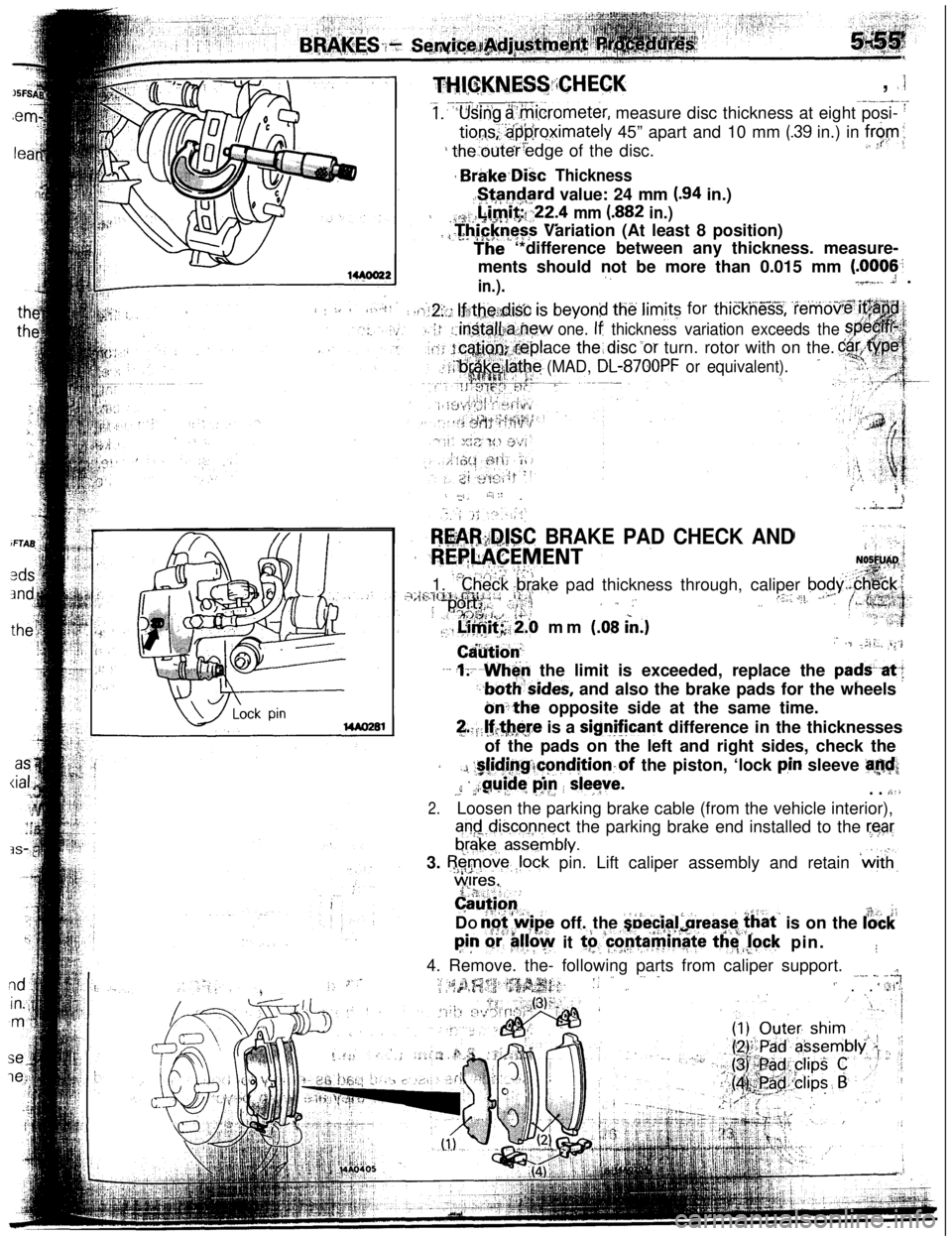
: : :.. t,:...!b
THl,~,KNES~i;CHECK, .‘i.- _d--.-.--.
1: ‘Using $.$i,crometer, measure disc thickness at eight posi- I
tions;:‘.@‘proximately 45” apart and 10 mm (.39 in.) in f,r$,m;,
i theouter’edge of the disc.‘I
+ Brbke.Disc Thickness..!+@Card value: 24 mm
(94 in.)
i,,~~~:-~4!-~~~t;:22.4 mm (.882 in.)
: ,aThrckness Variation (At least 8 position)
_ The ‘*difference between any thickness. measure-
ments should not be more than 0.015 mm
(.0006:
in.).,,7.9’-,... .J .
: .A12fi: If~thei;di& is beyond t& Jim@ for thickneT.%, ‘ie’mdv.,.
one. If thickness variation exceeds theace the:disc”or turn. rotor with on the.
(MAD, DL-87OOPF or equivalent).-
;_:.j ::!‘_, Ii..;, ‘I
t&;&C BRAKE PAD CHECK AND
., . .:L”” cn:
,.,1. ~:“ch&ii -brake pad thickness through, caliper body$%ck.~:?;{&:?p., d ii,; ,i..i; I&+# ~4:‘ ” :’/I..: “j.. .
~~Tl$$$‘~&b mm (08 cn.)
-.‘-‘: (~~#&q,,I,.:: y;./.
C&&ion”,- ‘-, -, iii,,, I.“‘?,t
--. +-When the limit is exceeded, replace the pad&at-:
,--both&sides, and also the brake pads for the wheels
onth-e opposite side at the same time.&.Jf,tb@re is a
signjfjcant difference in the thicknesses
of the pads on the left and right sides, check the
A.J. :%!idi,~g!~ondStion.of the piston, ‘lock p,in sleeve ;a,$$
f * ,midq py I sleye._, ,: .’ i.. . ii’.
2.Loosen the parking brake cable (from the vehicle interior),
an$dis.co-nnect the parking brake end installed to the rearI II Iorake,. assemory.3.
f5$_move.,lock pin. Lift caliper assembly and retain ‘&h,
yps..,(y&on,DO
r$$v$e off. the stiecial!.grease. that’ is on the &ckpi”
cii’@!fow it to..c,ontait;inate tl;
f :.,3-:: ” ,, ” -_.__ _, .“_,./‘7,.< :$, ~. . 6
Page 14 of 57

BRAKES -Brake BoosterVacuum hose
14AO39414u0050Semidrvina sealant
141626Vacuum hose
IChevk valve
mm (in.)
14AO395
SERVICE PO@JTS OF REMOVALNocm6.
REM&AL OF VACUUM HOSE WITH CHECK VA+
NOTE
Since the check valve is fit to the vacuum hose, replace thcheck valve as an assembly unit together with the
vacuurhose if the check valve is defective.
SERVICE POINTS OF INSTALLATION
10. APPLDJTION OF GREASE TO CLEVIS PIN/g. WASHEIAfter applying the specified grease to the
clevis pin an
washer, insert the
cievis pin and bend the cotter pin tightlyGrease: MOPAR Multi-mileage Lubricant
Part No. 2525035 or equivalent
7. APPLICATION OF SEALANT TO FITTING
When installing the vacuum hose fitting, apply
semi-cfryin!sealant to its threaded portion.
6. INSTALLATION OF VACUUM HOSE WITH CHECK
VALVE
(1) Attach the vacuum hose so that it may be inserted to a
dimension illustrated.
Caution
Prevent interference between the check valve and
brake booster.
(2) The vacuum hose at the engine should be securely
connected until it contacts the hexagonal edge of the
fitting, and then should be secured by the hose clip.
Page 15 of 57
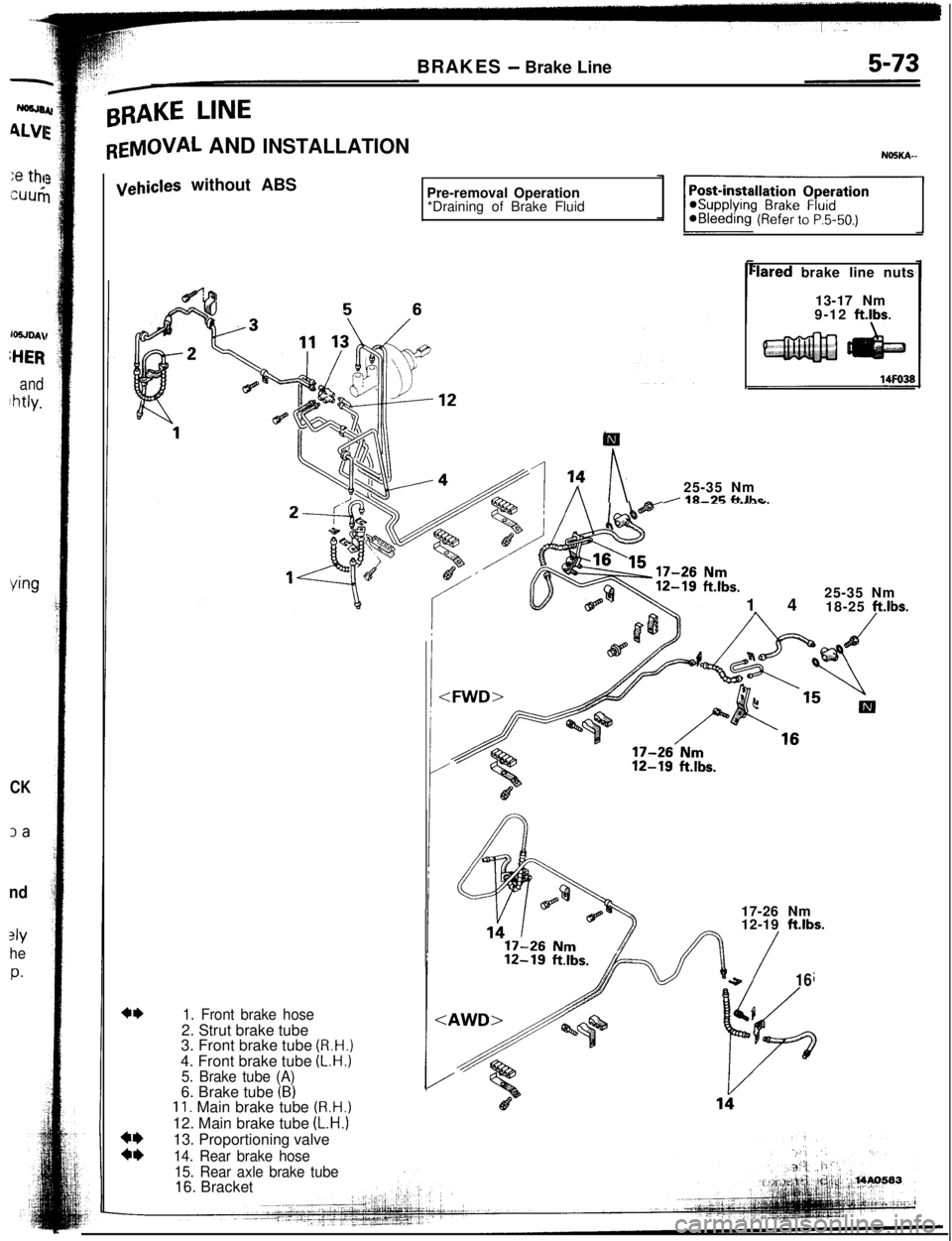
N0sJa
4LVI
:e the
cuu<
‘=JD4\
;HER
and
!htly.
Wg
CK3a
nd
3ly
he
P.BRAKES
- Brake Line
BRAKE LINE
REMOVAL AND INSTALLATIONNOSKA--
1. Front brake hose2. Strut brake tube
3. Front brake tube
(R.H.)4. Front brake tube
(L.H.)5. Brake tube (A)6. Brake tube (B)11. Main brake tube (R.H.)12. Main brake tube
(L.H.)13. Proportioning valve
14. Rear brake hose
15. Rear axle brake tube
._-
Ill
n25-35 NmI 111-7G f-t Ihr:lared brake line nuts
13-17 Nm
9-12
ftlbs.
vehicles without ABS
Pre-removal Operation
*Draining of Brake Fluid
1425-35 Nm
18-25
ft.lbs.17-26 Nm
12-19
ft.lbs.
+1616. Bracket
Page 16 of 57
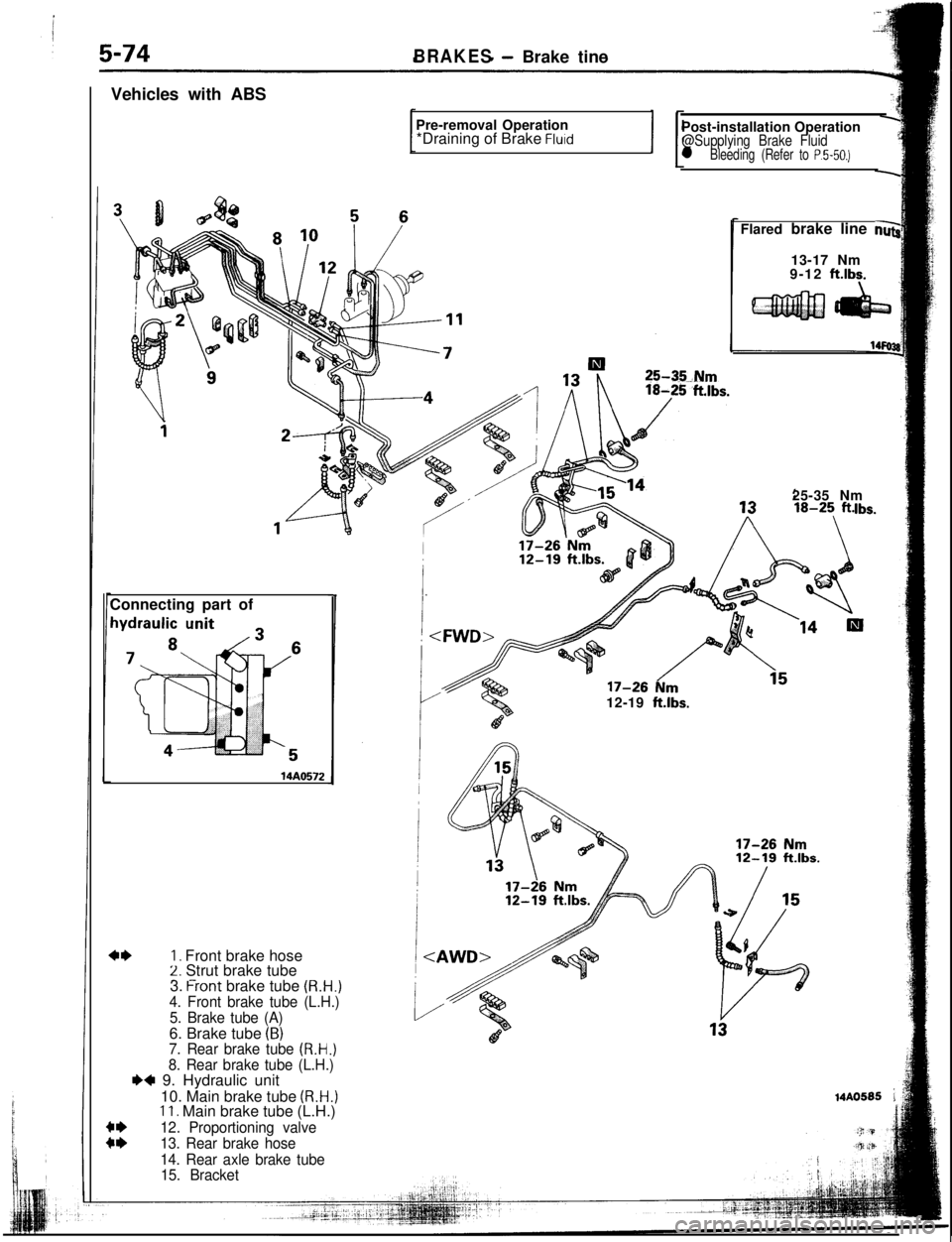
a-.
i.-J
5-74BRAKES- Brake tine
Vehicles with ABS
Pre-removal Operation
*Draining of Brake
Fluid
,“iPost-installation OperationA
@Supplying Brake Fluid1
l Bleeding (Refer to P.5-50.)
-Connecting part of
14AO572
I. Front brake hose2. Strut brake tube- -25-35 Nm
Ibs.12-19
ft.lbs.Flared brake line
ns13-17 Nm
9-12
ftlbs.
15. Bracket3.
f-ront brake tube (R.H.)
4. Front brake tube (L.H.)
5. Brake tube (A)6. Brake tube
(B)7. Rear brake tube (R.H.)
8. Rear brake tube (L.H.)I)+ 9. Hydraulic unit
10. Main brake tube
(R.H.)11. Main brake tube (L.H.)
::
12. Proportioning valve
13. Rear brake hose
14. Rear axle brake tube
14AO585 ;
Page 17 of 57
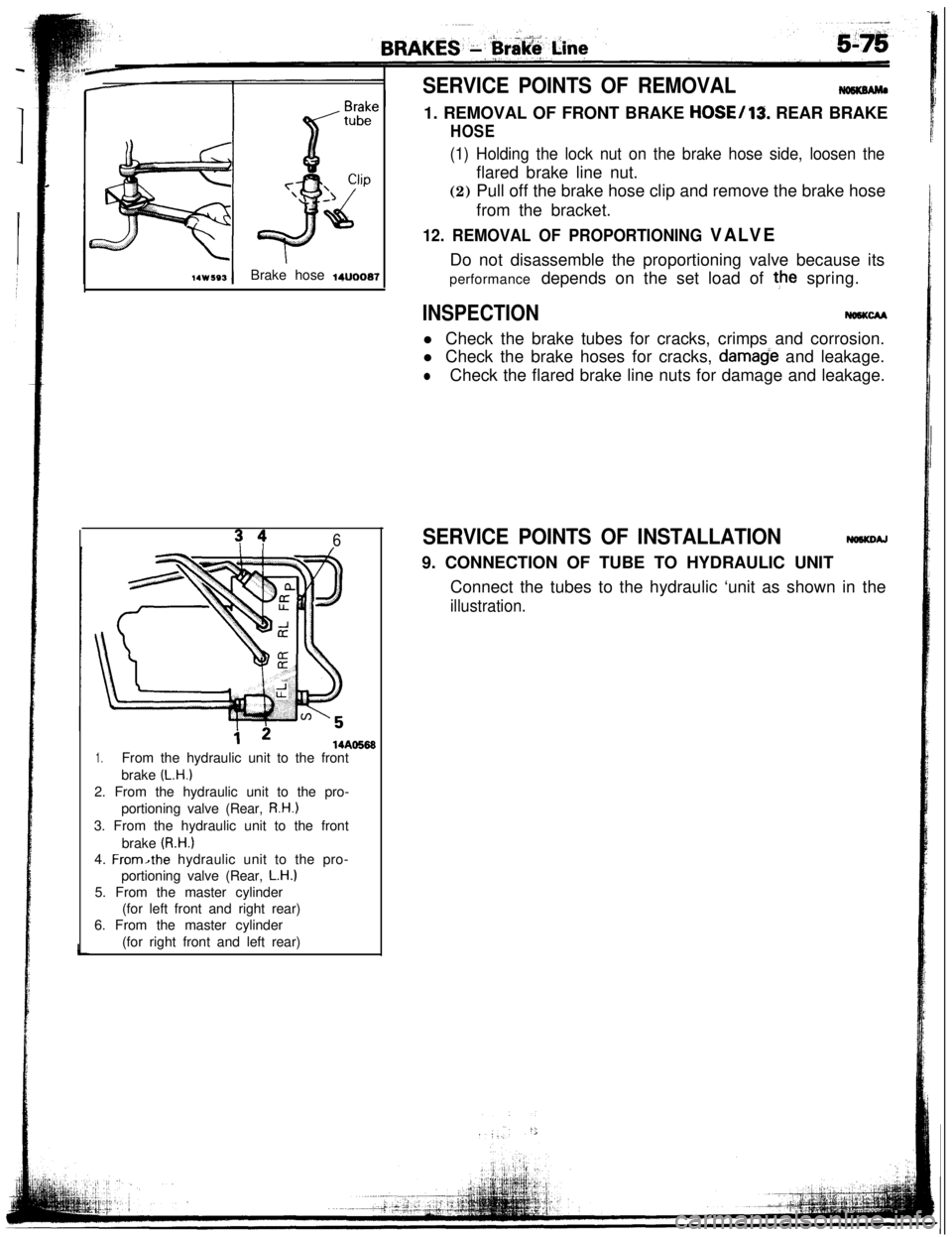
SERVICE POINTS OF REMOVAL
14w593Brake hose woo07
s 461. REMOVAL OF FRONT BRAKE
HOSE/13. REAR BRAKE
HOSE
(1) Holding the lock nut on the brake hose side, loosen theflared brake line nut.
(2) Pull off the brake hose clip and remove the brake hose
from the bracket.
12. REMOVAL OF PROPORTIONING VALVEDo not disassemble the proportioning valve because its
performance depends on the set load of the spring.
INSPECTIONNo6KcMl Check the brake tubes for cracks, crimps and corrosion.
l Check the brake hoses for cracks,
damade and leakage.
lCheck the flared brake line nuts for damage and leakage.
SERVICE POINTS OF INSTALLATIONNOSKOAJ9. CONNECTION OF TUBE TO HYDRAULIC UNIT
Connect the tubes to the hydraulic ‘unit as shown in the
illustration.
i 214AO5681.From the hydraulic unit to the front
brake
(L.H.)2. From the hydraulic unit to the pro-
portioning valve (Rear,
R.H.)3. From the hydraulic unit to the front
brake
(R.H.)4. From,the hydraulic unit to the pro-
portioning valve (Rear,
L.H.)5. From the master cylinder
(for left front and right rear)
6. From the master cylinder
(for right front and left rear)
Page 18 of 57
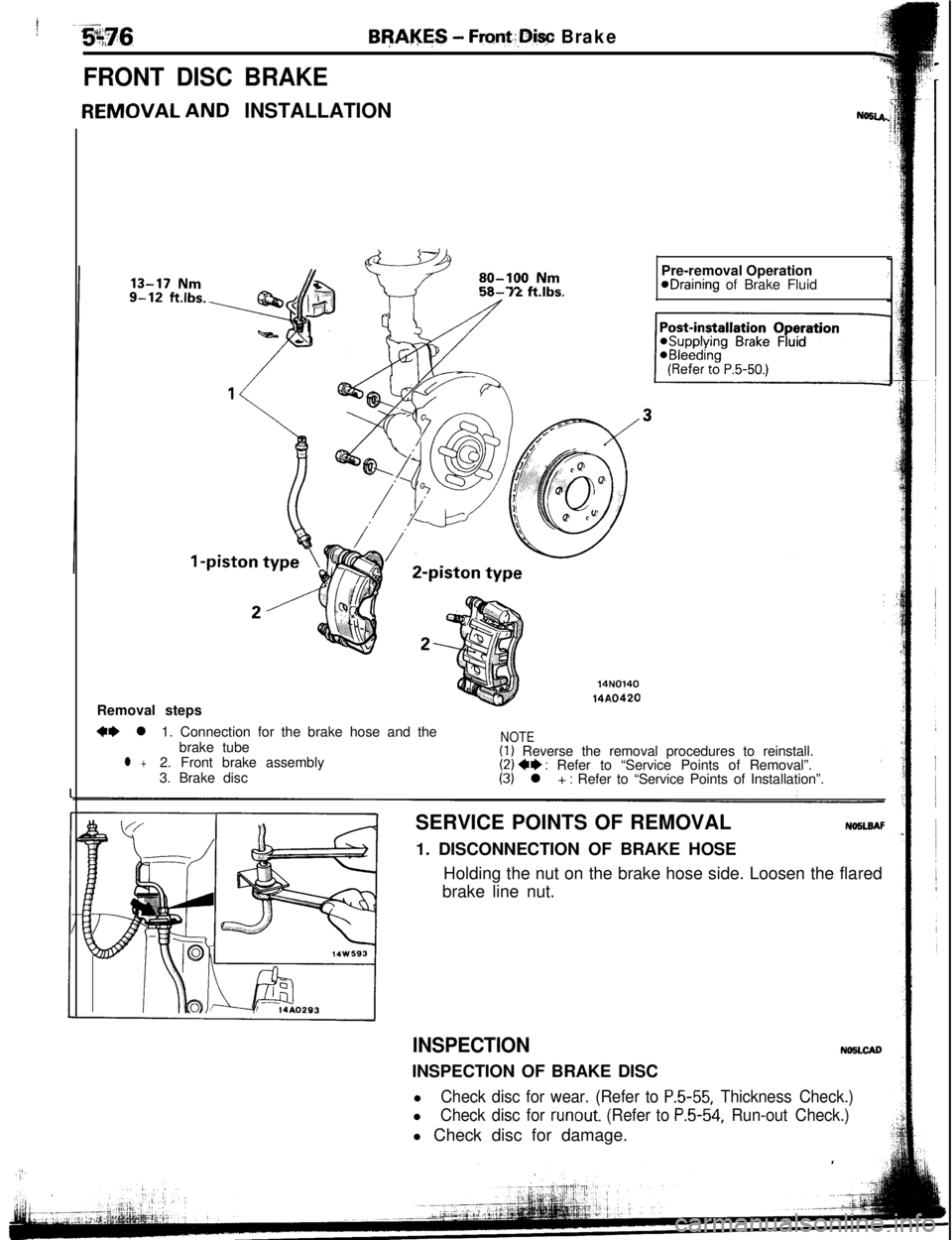
! -;-596
FRONT DISC BRAKE
Bf?Al$ES - Front.:,Diw Brake
REMOVAL AND INSTALLATIONN=U.
3U- IL l-LIDS.Y-i A
14N014014A0420Pre-removal Operation
eDraining of Brake Fluid
Removal steps
+e l1. Connection for the brake hose and the
brake tubeNOTE
l +2. Front brake assembly(1) Reverse the removal procedures to reinstall.
3. Brake disc(2) ++ : Refer to “Service Points of Removal”.(3) l + : Refer to “Service Points of Installation”.
SERVICE POINTS OF REMOVAL
No5LsAF1. DISCONNECTION OF BRAKE HOSE
Holding the nut on the brake hose side. Loosen the flared
brake line nut.
INSPECTIONNNiLCIDINSPECTION OF BRAKE DISC
l
Check disc for wear. (Refer to P.5-55, Thickness Check.)l
Check disc for runout. (Refer to P.5-54, Run-out Check.)l Check disc for damage.
Page 19 of 57

-
3AF
:dSERVICE POINTS OF INSTALLATION
NOBLDAG2.
INSTILLATION OF FRONT BRAKE ASSEMBLY
14AO399Measure the disc brake drag force after installation of the
brake assembly by the following procedure.(1) With the brake assembly removed, use a spring bal-
ance to measure the rotation sliding resistance of the
hub in the forward direction.
NOTE
Tighten the nuts in order to secure the disc to the hub.(2) After installing the caliper support to the knuckle,
expand the piston, and then install the caliper body.
(3) Start the engine, and after depressing the brake pedal
hard two or three times, stop the engine.
(4) Turn brake disc forward 10 times.
(5) Use a spring balance to measure the rotation sliding re-
sistance of the hub in the forward direction.(6) Calculate the drag torque of the disc brake (difference
between measured values in 5 and 1).Standard value: 70
N (15.4 Ibs.) or less
(7) If the disc brake drag force exceeds the standard value,
disassemble piston and’clean the piston. Check for cor-
rosion or worn piston seal.
Page 20 of 57

-.
t
5-78BRAKES - Front Disc Bra&.iDISASSEMBLY AND REASSEMBLY
NO51
< 1 -piston type>
64-86
46-62
64-86
46-6216
/
w”! 14N0284
Caliper assembly disassembly steps
M 1. Guide pin
l + 2. Lock pin
l + 3. Bushing
4. Caliper support (Pad, clip, shim)
l + 5. Guide pin bootMI 6. Lock pin boot
**7. Boot ring4*8. Piston boot
l *** 9. Piston
+I) l * IO. Piston seal11. Brake hosel + 12. Caliper body
Pad assembly disassembly steps
e+ 1. Guide pin
l + 2. Lock pin*+ 3. Bushing4. Caliper support (Pad, clip, shim)
13. Pad and wear indicator assembly
14. Pad assembly
++ 15. Outer shim16. Clip
e+ 17. Inner shim
NOTE
(1) Reverse the disassembly procedures to reassemble.(2)
~~ : Refer to “Service Points of Disassembly”.(3) l + : Refer to “Service Points of Reassembly”.
(4) m : Non-reusable parts
1
i14AO537Brake caliper kit
Pad repair kitSeal and boots
repair kit
10 6
5’ 8 7
-.I.14AD54(